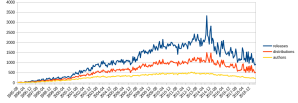This couple of months I’ve been casually looking at daily CPAN uploads, because I entered the Once-a-day-releases game. I notice that the uploads are getting scarcer and scarcer. So today I decided to take a look at monthly upload statistics. The result is summarized in the chart below which shows the number of monthly CPAN releases, unique distributions, and unique authors up to July 2019.
Indeed, the uploads have been diminishing recently, from 1215 in Apr, to 980 in May, 886 in Jun, and 944 in Jul. Not counting my own releases, it’s 1076 in Apr, 888 in May, 793 in Jun, and 753 in Jul. It’s sad to see that I affect the stats so significantly. I can’t be the only one still using Perl that much or actively in the whole wide world, am I?
One thing I want to point out is that, ironically, the tipping point is Aug 2014, when the first CPAN Day was organized. The number of releases peaked that month, but then have been steadily dwindling ever since.
Nowadays, CPAN gets 20-30 daily uploads on average; it was around 60-100 in 2014. Meanwhile Python’s PyPI page indicates that it gets at least 700-800 daily uploads. Interpret that as you wish, but Python is clearly eating everybody’s lunch. First it was Perl, then Ruby, then R.

Pingback: New top story on Hacker News: Dwindling CPAN Releases – News about world
Pingback: New top story on Hacker News: Dwindling CPAN Releases – Latest news
Pingback: New top story on Hacker News: Dwindling CPAN Releases – Hckr News
Pingback: New top story on Hacker News: Dwindling CPAN Releases – protipsss
Pingback: New top story on Hacker News: Dwindling CPAN Releases – World Best News
Pingback: New top story on Hacker News: Dwindling CPAN Releases – Outside The Know
Pingback: Dwindling CPAN releases – TechBits
Pingback: New top story on Hacker News: Dwindling CPAN Releases – Golden News
Pingback: Dwindling CPAN Releases – INDIA NEWS
You can see that Perl still has a hell of a lot more CPAN activity that it used to back in 2000-2005, when Perl was in it’s heyday, but there’s just so much more *stuff* being built today that Perl looks small by comparison.
LikeLike
Pingback: Dwindling CPAN Releases | Mark Beazley | MarkBeazley.Com
Pingback: Dwindling CPAN releases - RAM NETWORK
Pingback: Dwindling CPAN Releases – Hacker News Robot
Who are the biggest commercial users of Perl these days, is it still hotels.com?
LikeLike
You meant booking.com? Probably. That, and cPanel. They are always the two main sponsors for Perl events.
LikeLike
Net A Porter and Zoopla are up there.
LikeLike
I used to do everything in Perl. I started my career with it, did startup SaaS products with it, truly loved it. Pretty much my main language 98 through 2008ish. Still heavily used through 2012 but mostly because of maintaining things built earlier.
But it was hard as hell to find Perl programmers to hire. So slowly I started hiring PHP developers and more projects switched to PHP.
Then with Perl 5 / Perl 6 stuff happening, but to me at the time it appeared to be happening slowly, I lost interest in seeing where Perl was going.
So yeah, now my team (a few companies later) uses PHP (several big WP sites to maintain), Python (anything I can write in Python I do), and NodeJS (I’ll take this over PHP, but still not a favorite of mine).
At this point, I don’t know a damn thing about where Perl is now with 6. They lost me with that and I haven’t bothered looking back. Even if I wanted to, my original problem still stands: hard to hire for.
LikeLike
i disagree with your conclusions: the active/interesting people who moved away around me did it to find a job and none included python (but haskell, go, exilir, rust). also, people using perl for side projects (including myself) now use perl6.
LikeLike
Pingback: Stuff The Internet Says On Scalability For August 2nd, 2019 – AWS Feed